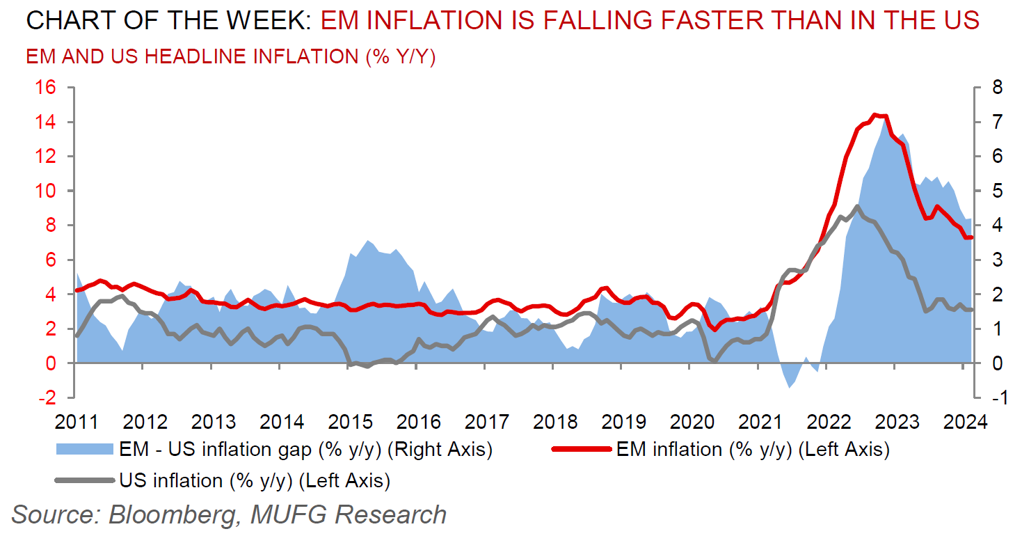To read the full report, please download the PDF above.
Inflation divergence continues across EM EMEA but mostly better news
EHSAN KHOMAN
Head of Commodities, ESG and
Emerging Markets Research –
EMEA
DIFC Branch – Dubai
T:+971 (4)387 5033
E: ehsan.khoman@ae.mufg.jp
RAMYA RS
Analyst
DIFC Branch – Dubai
T:+971 (4)387 5031
E: ramya.rs@ae.mufg.jp
LEE HARDMAN
Senior Currency Analyst
Global Markets Research
Global Markets Division for EMEA
T: +44(0)20 577 1968
E: lee.hardman@uk.mufg.jp
PAUL FAWDRY
Head of Emerging Markets FX Desk
Emerging Markets Trading Desk
T: +44(0)20 577 1804
E: paul.fawdry@uk.mufg.jp
MUFG Bank, Ltd.
A member of MUFG, a global financial group
Macro focus
Inflation divergence continues to remain a central theme across EM EMEA. January witnessed mixed inflation readings with rapid disinflation across the CEE region and South Africa, contrasted with economies elsewhere that have witnessed slightly rising headline inflation prints in annualised terms. However, in recent months, inflation has tended to surprise to the downside in both low and high-inflation economies alike. Substantial FX divergence in H1 2023 has played an important role in driving inflation divergence. Exchange rates have been more stable since the summer, so the importance of these factors is likely to fade as the year progresses. Substantial FX divergence in H1 2023 has played an important role in driving these dynamics. However, exchange rates have been more stable since last summer, and thus the significance of these factors will likely ebb as 2024 evolves. Given mixed inflation dynamics, we expect a significant divergence in monetary policy this year. In the CEE region, we forecast a sharper decline in rates through 2024 (5.00% in Poland, 3.25% in Czech Rep., 5.00% in Hungary, and 4.50% in Romania). In South Africa, we expect rates to end the year at 7.25%. Set against this, we expect further tightening in the coming months in Egypt (24.00%) and Nigeria (24.75%) – see here.
FX views
EM FX stages modest relief rally after US yields lose some upward momentum. The hawkish repricing in the US rate market has lost momentum indicating that the market is becoming more comfortable that rate cut expectations have been scaled backed sufficiently at the current juncture. The other main event risk for emerging market currencies in the week ahead will be the outcome from the annual National People’s Congress in China which begins on 5th March.
Week in review
Israel kept its policy rate on hold at 4.50%, while Hungary reduced its key rate by 100bp to 9.00%. Meanwhile, Nigeria hiked its key rates by 400bp to 22.75%. Turkey reported growth in Q4 2023 GDP at 4.5% y/y and February CPI at 67.1% y/y.
Week ahead
Central bank meeting is scheduled in Poland, where expect rates to remain on hold at 5.75%. February inflation data is due for release in Hungary and Ukraine. Meanwhile, GCC countries’ PMI print will also be published for February.
Forecasts at a glance
Growth across the EM universe is set to stabilise as domestic fundamentals offset external drags, with some rotation from the largest to smaller EMs. Inflation and interest rates are both “over the hump” – disinflation is progressing, and the decline in rates will continue and broaden in 2024 (see here).
Core indicators
EM securities attracted USD3.8bn in the week ending 01 March – equity and debt flows were USD4.2bn and USD-0.4bn, respectively.




